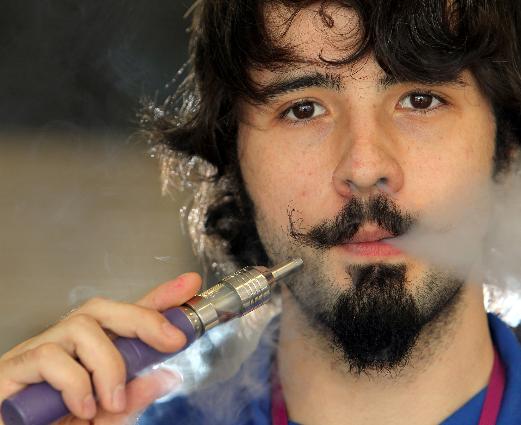Electronic cigarettes could rekindle battles over smoking in public
Article by: ANDREW WAGAMAN, Star Tribune
It was trivia night, and Michael Jamnick didn’t want to leave the TGI Friday’s in Maple Grove to go outside and have a smoke. So he started puffing right where he sat.
The 27-year-old from Minnetonka wasn’t breaking the law: He was using an electronic cigarette.
Still, Jamnick said he felt uncomfortable vaping (the e-cigarette term for lighting up).
“It’s been, what, six years now since they passed the smoking ban in Minnesota?” he said. “You give it a funny look because you haven’t seen it in a while.”
Electronic cigarettes have been on a slow burn for years, but they’ve recently caught fire. National sales jumped to $500 million in 2012 and are projected to clear $1 billion this year. In the Twin Cities, at least a dozen e-cigarette specialty shops have opened and shop owners say the growing business will likely see a boost from the $1.60-a-pack tobacco tax hike, which went into effect July 1.
The e-cigarette industry is promoting vaping as a hip, healthier alternative to smoking — and as a way to quit. But while health experts largely agree that the vapor from e-cigarettes poses less of a threat to public health than tobacco cigarettes, some worry that welcoming the so-called “clean nicotine” could erode smoking bans, encourage smokers to trade one addiction for another and hook nonsmokers.
“Shifting entirely over to vaping from smoking would be a big public health plus,” said Robert Proctor, a history of science professor at Stanford University. “But the question of whether e-cigarettes are good or bad isn’t that simple.”
Supplanting cigarettes?
E-cigarettes are battery-powered devices that create a vapor mist from a heated liquid solution when the user inhales on a mouthpiece. The solution, or “e-juice,” and vapor mist, which looks like smoke, typically contain nicotine, but users can regulate the amount. That’s why some vapers say e-cigarettes have helped them quit tobacco — and wean themselves off nicotine altogether.
Research released in late June by Italy’s University of Catania lends support to those claims. The study found that 13 percent of participants who used high-dose e-cigarettes quit smoking. Seventy percent of those who quit smoking eventually gave up e-cigarettes, too.
“As evidenced in this study, when people switch to electronic cigarettes, it absolutely makes it easier to quit nicotine use completely,” said Michael Siegel, a professor at Boston University School of Public Health who studies e-cigarettes. “It’s not as simple as saying people are substituting one addiction for another.”
In fact, Siegel said the quit-rate for e-cigarettes is comparable to rates in other nicotine-replacement therapy studies.
But others maintain that it’s not yet known how harmful vaping could be.
“We frankly don’t know much about them,” said Robert Moffitt, an American Lung Association media relations director.
Concerns about harm from secondhand vapor are not at the forefront. While a 2012 German study found that the vapor is an “aerosol of ultrafine particles,” no studies have shown it to be dangerous. But Moffitt and others question claims that e-cigarettes can help smokers quit.
“We’d strongly recommend anyone from using them,” he said, “especially with so many other valid smoking-cessation devices and techniques that we know work.”
He also doubts that the e-cigarette industry, which includes big tobacco companies, would encourage people to stop using nicotine entirely. “They’re looking for new young people to get hooked on nicotine products,” he said, “and e-cigarettes seem to be the latest.”
Stanford’s Proctor, however, sees both the promise and the threat in the recent rapid spread of e-cigarettes.
“E-cigs seem to offer us the possibility of keeping the addiction, while losing the cancer,” he said. “But is addiction itself a bad thing? That question is splitting the public health community, and it’s not yet clear which direction we’ll go.”
Bans cropping up
Michael “Troop” Wolberg, 41, used to smoke two packs of cigarettes a day. After trying to quit several times, he turned to e-cigarettes. On his third day of vaping, the Stacy, Minn., man says he lit his last cigarette. Since then, he’s become a champion of e-cigarettes. He’s written online reviews of vaping products, become a member of the Minnesota Vapers Club and helps run an online business that sells flavored e-juice.
Wolberg, who calls himself an advocate of “tobacco harm reduction,” isn’t shy about using his e-cigarette. “I’m rather proud to display it in public because I think it needs to be seen,” he said.
Cynthia Hallett couldn’t disagree more. Hallett, executive director of Americans for Nonsmokers’ Rights, says vaping could undermine the hard-won battles to establish non-smoking areas.
Proctor echoes her concerns. “If you can’t tell whether someone is vaping or smoking, that could work to erode established no-smoking zones,” he said.
So far, e-cigarettes aren’t widely regulated.
In 2012, Minnesota passed a law banning the sale of e-cigarettes to minors. But, in part because e-cigarettes don’t burn anything, they haven’t been legally prohibited in public places. (This spring the St. Paul City Council proposed banning e-cigarettes in indoor public spaces, but the proposal was dropped.)
However, the electronic cigarettes have been banned in K-12 schools in the state and some colleges and universities also have moved to ban them.
“It was part of promoting a healthier lifestyle and clean environment for our students,” said Amber Luinenberg, coordinator of communications for Minnesota West Community and Technical College, which prohibits vaping on its five outstate campuses. “I think students in particular are very accustomed to tobacco-free locations, so there was no controversy at all. They were very receptive to it.”
Managers at local restaurants and bars say they are just starting to see people use e-cigarettes in their establishments. While some have banned them, others are taking a wait-and-see approach.
Parasole Restaurant Holdings bans vaping at its restaurants, said Kip Clayton, public relations director. “To not do so when dealing with thousands of people a night,” at restaurants like Uptown Cafeteria and Chino Latino, “would be inviting trouble,” he said.
The Lung Association’s Moffitt hopes legal measures will be taken to ban e-cigarettes in public places before they become more common.
“Maybe we need to put the kibosh on these right now,” he said.
For now, using e-cigarettes may come to down to common courtesy.
Jamnick, who has quit smoking cigarettes, doubts he’ll use his e-cigarette much anymore when he’s out.
“Generally, I try to avoid using it around other people,” he said, “because some people just don’t like it.”
http://www.startribune.com/lifestyle/health/215258211.html?page=1&c=y



